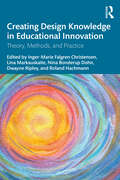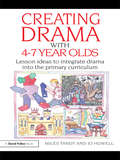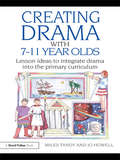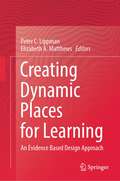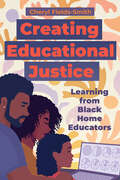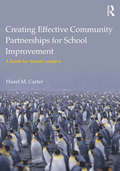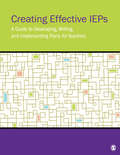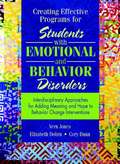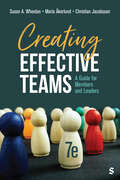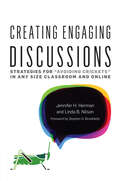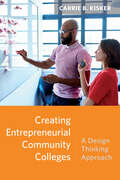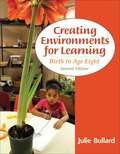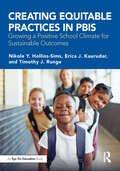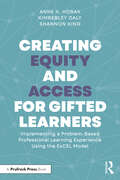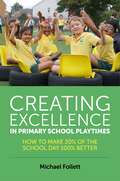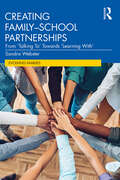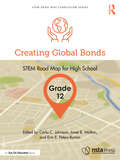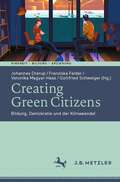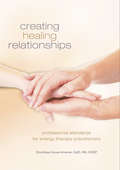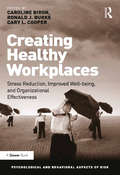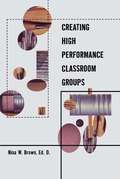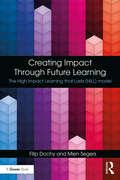- Table View
- List View
Creating Design Knowledge in Educational Innovation: Theory, Methods, and Practice
by Lina Markauskaite Nina Bonderup Dohn Dwayne Ripley Roland Hachmann Christensen, Inger-Marie FalgrenExamining how research-informed design knowledge is created, represented, and used in educational research and innovation projects, this book offers theoretical, methodological, and practical guidance on how to (and how not to) create, represent, and (re)use research-informed design principles.The chapters explore how educational researchers, designers, teachers, and other innovating practitioners can make outcomes of educational research and innovation projects scalable, readily applicable in educational design, and impactful on practice. They offer methodological "know-how" that is theoretically robust and grounded in research and design experiences. Providing critical reflection on current theories, methods, and practices, this book also considers directions for the future in light of developments in semantic web technologies, AI, and other emerging technologies.This book is a helpful guide for researchers, research students, and innovation designers who aim to produce and apply design knowledge that is robust, grounded in research, and practically useful as a part of diverse research and innovation projects.
Creating Drama with 4-7 Year Olds: Lesson Ideas to Integrate Drama into the Primary Curriculum
by Miles Tandy Jo HowellThis practical book gives you all the ideas you need to make drama a regular and integral part of your school’s curriculum, offering detailed suggestions of drama work for ages four to seven. The teaching units are arranged around four strands: drama for literacy; drama and the whole curriculum; drama film, media, and ICT; and drama for performance. The authors provide a wealth of practical activities throughout. Each unit includes: explicit links to the Renewed Framework for literacy and the wider curriculum a list of resources needed clear learning objectives and outcomes steps for teaching and learning including how to modify activities to suit your school links to writing assessment guidance. Based on the authors’ experience as teachers and in-service trainers, this book provides a Wide range of ideas and activities for inspiring drama across the Foundation Stage and Key Stage 1, and is essential reading for all those interested in bringing drama into their school.
Creating Drama with 7-11 Year Olds: Lesson Ideas to Integrate Drama into the Primary Curriculum
by Miles Tandy Jo HowellThis practical book gives you all the ideas you need to make drama a regular and integral part of your school’s curriculum, offering detailed suggestions of drama work for ages 7 to 11. The teaching units are arranged around four strands: drama for literacy; drama and the whole curriculum; drama film, media, and ICT; and drama for performance. The authors provide a wealth of practical activities throughout. Each unit includes: explicit links to the Renewed Framework for literacy and the wider curriculum a list of resources needed clear learning objectives and outcomes steps for teaching and learning including how to modify activities to suit your school links to writing assessment guidance. Based on the authors’ experience as teachers and in-service trainers, this book provides a wide range of ideas and activities for inspiring drama across Key Stage 2, and is essential reading for all those interested in bringing drama into their school.
Creating Dynamic Places for Learning: An Evidence Based Design Approach
by Peter C. Lippman Elizabeth A. MatthewsThis book showcases how an evidence-based design approach can be utilized in the planning of learning environments, by acknowledging the interconnectedness of research, practice, and theory as core considerations in the design of learning environments. Toward this end, this volume explores a multi-disciplinary perspective that draws upon modern learning theories, and empirical research from the fields of environmental psychology education, and architectural practice. By presenting this information in an accessible manner, it enables researchers, educators and designers to take actionable steps needed to re-imagine their settings and create dynamic places for learning.
Creating Educational Justice: Learning from Black Home Educators
by Cheryl Fields-SmithA thoughtful, research-based discussion of Black homeschool experiences as models for educational improvement in K–12 public education
Creating Effective Community Partnerships for School Improvement: A Guide for School Leaders
by Hazel M. CarterCreating Effective Partnerships for School Improvement places the school within the community which is composed of a number of key players, including school leaders, classroom teachers, private foundations, higher education institutions, business and community based organizations, and government agencies. This book encourages leaders to embrace this broader community of stakeholders and to focus on the often overlooked and underutilized college and university partnerships. Grounded in case study analysis of innovative programs and practices, this book explores research-based strategies for educational leaders to implement in order to develop and sustain effective partnerships. Creating Effective Partnerships for School Improvement is an important text for aspiring and practicing administrators interested in creating effective partnerships for school improvement. Special Features: Reflective exercises and portfolio building activities help aspiring and practicing leaders make on-the-ground connections. Learning objectives, key terms, and additional resources further engage readers with the chapter content. Extensive appendices with sample activities, evaluation plans, meeting agendas, promotional materials, and budgets provide additional support to leaders. Alignment to the Educational Leadership Constituent Council (ELCC) Standards.
Creating Effective IEPs: A Guide to Developing, Writing, and Implementing Plans for Teachers
by Nancy BurtonCreating Effective IEPs: A Guide to Developing, Writing, and Implementing Plans for Teachers is a brief primer on Individualized Education Plans that has been developed as a custom supplement for textbooks in Introduction to Education, Introduction to Inclusion, and SPED Teaching Strategies. The Individualized Education Plan is one of the most important parts of an exceptional child’s education – it is the document shared among teachers, administrators, paraprofessionals and parents that outlines the accommodations and strategies for educating a child with special needs. An effective IEP must be well-thought out, clearly defined, and embraced by all parties involved in a child’s education, including administrators and parents. This primer provides practical instruction for writing IEPs, leading IEP meetings, and implementing the goals in a classroom setting. Practical exercises and real-world appendices help make the material accessible for students preparing to enter the workforce.
Creating Effective IEPs: A Guide to Developing, Writing, and Implementing Plans for Teachers
by Nancy BurtonCreating Effective IEPs: A Guide to Developing, Writing, and Implementing Plans for Teachers is a brief primer on Individualized Education Plans that has been developed as a custom supplement for textbooks in Introduction to Education, Introduction to Inclusion, and SPED Teaching Strategies. The Individualized Education Plan is one of the most important parts of an exceptional child’s education – it is the document shared among teachers, administrators, paraprofessionals and parents that outlines the accommodations and strategies for educating a child with special needs. An effective IEP must be well-thought out, clearly defined, and embraced by all parties involved in a child’s education, including administrators and parents. This primer provides practical instruction for writing IEPs, leading IEP meetings, and implementing the goals in a classroom setting. Practical exercises and real-world appendices help make the material accessible for students preparing to enter the workforce.
Creating Effective Programs for Students with Emotional and Behavior Disorders
by Cory Dunn Elizabeth Dohrn Vern JonesThis exiting new book provides special educators, school psychologists, and others responsible for programs for students serving students with EBD with specific methods, supported by sound research and proven by practice, for developing or improving services to this student population. While several current books provide excellent discussions concerning characteristics of students with EBD and describe some methods that have been effective in helping these students improve their behavior, this is the only book to provide a thorough, comprehensive examination of concepts and strategies needed to effectively develop and implement a program for this student population. special educators, school psychologists, therapists.
Creating Effective Teams: A Guide for Members and Leaders
by Susan A. Wheelan Maria Åkerlund Christian JacobssonCreating Effective Teams: A Guide for Members and Leaders provides expert-backed strategies for cultivating top-performing teams across public and private industries. The updated Seventh Edition offers cutting-edge methodologies tailored to modern work dynamics, supporting maximum productivity and collaboration.
Creating Effective Teams: A Guide for Members and Leaders
by Susan A. Wheelan Maria Åkerlund Christian JacobssonCreating Effective Teams: A Guide for Members and Leaders provides expert-backed strategies for cultivating top-performing teams across public and private industries. The updated Seventh Edition offers cutting-edge methodologies tailored to modern work dynamics, supporting maximum productivity and collaboration.
Creating Engaging Discussions: Strategies for "Avoiding Crickets" in Any Size Classroom and Online
by Linda B. Nilson Jennifer H. HermanIf you have ever been apprehensive about initiating classroom discussion, fearing silences, the domination of a couple of speakers, superficial contributions, or off-topic remarks, this book provides strategies for creating a positive learning experience.Jennifer H. Herman and Linda B. Nilson demonstrate how to create the conditions to facilitate deep and meaningful learning as well as to assess the effectiveness of discussions. They identify, analyze, and solve common problems in both classroom and online discussions and in both small and large classes. They take a direct, practice-oriented approach that--in acknowledging common challenges--provides principles, guidance on design, examples of activities and techniques, and eight detailed case studies. These cases demonstrate successful approaches that faculty across disciplines and from a variety of institutions have adopted in their face-to-face, blended, or online courses at the undergraduate or graduate level. The case authors begin by describing the original pedagogical challenge they faced and explain how they addressed it and assessed the results of their innovation. They also offer practical recommendations to readers who may want to try their strategies. Intended for faculty, this book will be equally valuable for educational developers who can use this resource in their programs and private consultations. At the graduate level, this book can serve as a text or workshop resource in college teaching courses and teaching assistant development programs. The final chapter provides a set of resources and activities – including discussion questions on the case studies, writing prompts, and jigsaw formats – that are equally appropriate for individual study or for use in workshop environments. You’ll never again have to suffer such a profound silence that, as described by a contributor to the book, she could hear the crickets chirping outside.
Creating Entrepreneurial Community Colleges: A Design Thinking Approach
by Carrie B. KiskerIn this book, Carrie B. Kisker illustrates how community colleges can utilize design thinking to identify and evaluate entrepreneurial opportunities, and experiment with the internal changes necessary to optimize outcomes for stakeholders. Kisker outlines a process whereby college leaders can empower faculty and staff to think creatively about how to reduce their institution&’s dependence on state allocations in ways that not only are consistent with the college&’s mission and values, but also provide the greatest likelihood for institutional and student success.The book presents evidence drawn from case studies at four community colleges along with in-depth qualitative interviews with leaders, faculty, and staff who have been involved in their institution&’s entrepreneurial efforts. The featured colleges—Maricopa Community Colleges (AZ), Tarrant County College (TX), North Iowa Area Community College, and Valencia College (FL)—all have long histories of engaging in entrepreneurial initiatives.By telling the stories of several influential community college leaders&’ experiences with entrepreneurship—using design thinking as a framework for understanding their successes and failures—Kisker provides a road map for colleges to move beyond their historical pattern of incremental responses to external pressures, and instead begin to innovate in a creative, mission-oriented way.
Creating Environments for Learning: Birth to Age Eight (Second Edition)
by Julie BullardThis book is designed for college courses taught at institutions that focus on quality early childhood learning environments and curriculum.
Creating Equitable Practices in PBIS: Growing a Positive School Climate for Sustainable Outcomes
by Timothy J. Runge Nikole Y. Hollins-Sims Erica J. KaurudarThis go-to resource guides educators on how to incorporate equitable practices in a PBIS framework. The authors cover core concepts including school-wide positive behavioral interventions and supports (SWPBIS) and multi-tiered system of supports (MTSS), define equity, and present methods for enhancing implementation practices through an equity mindset. Chapters also include an analysis of team structures and the evaluation of baseline data sources, walking readers through how to incorporate effective practices to support an integrated MTSS framework and produce sustainable outcomes. This book is ideal for educators, behavioral specialists, and administrators who wish to promote a positive school climate and purposeful educational relationships.
Creating Equity and Access for Gifted Learners: Implementing A Problem-Based Professional Learning Experience Using the ExCEL Model
by Shannon King Anne Horak Kimberley DalyCreating Equity and Access for Gifted Learners provides an overview of how and why to implement the ExCEL Problem-based Learning Instruction Model as a change initiative in classrooms, and the impact that this model has had on gifted programs.The product of evidence from two federally-funded Jacob K. Javits grants, The ExCEL Model is a systemic, design-based, continuous improvement curriculum and professional learning program that closes equity gaps for culturally, linguistically, and economically diverse students by increasing effective problem-based learning (PBL) instruction. This book will provide readers with the background, evidence, and tools necessary to implement the program model as a change initiative in their schools. Learn how to implement effective, research-grounded professional learning, demonstrate best practices, and navigate red tape and roadblocks.Full of immediately implementable strategies and lesson examples, this book is a must have resource for district leaders, instructional leaders, and teachers ready to make their dream of implementing an equitable and effective professional learning program a reality.
Creating Excellence in Primary School Playtimes: How to Make 20% of the School Day 100% Better
by Michael FollettSchool playtimes account for 20% of a child's school life, but how can schools ensure that this time is as beneficial as possible for primary school pupils? Emphasising the importance of play in child development, this book identifies the key challenges facing schools during break times and sets out a complete strategy for effectively managing playtimes that are fun-filled and offer children greater long-term benefits. With before and after case studies showing how school playtimes have been transformed through the author's OPAL Primary Programme, this book demonstrates how to improve common issues such as behaviour, staffing, space and facilities in a sustainable way that capitalises on investments in equipment and training. Promoting wellbeing and healthy child development, this book provides inspiring reading for primary school staff and play workers, and creative ideas and ready-to-use solutions that will help schools to meet Ofsted criteria for excellent play.
Creating Family–School Partnerships: From ‘Talking To’ Towards ‘Learning With’ (Evolving Families)
by Sandra WebsterIntroducing a new model of family–school partnership, entitled ‘Pathways to Partnership’, Sandra presents a template to teachers and school leaders for developing authentic, genuine family–school partnerships that reflect contemporary global thinking and practice. She offers a new perspective on the family–school partnership, and provides support and guidance to school leaders to move away from outdated but ingrained approaches to more effective family–school partnerships. Globally, schools are becoming less an education centre and more of a hub that integrates health and social services. With this change, the way schools regard family involvement has also shifted, with family involvement being viewed as a strategically critical role. This shift has been influenced not just by the recent pandemic, but also by the global trend towards decentralisation and democratisation of the decision-making power in schools, in which parent empowerment is implicit. However, many schools have not followed a modern engagement model in the way they approach partnership with the family, and still espouse approaches that are school centric and outdated in their orientation. Pathways to Partnership helps move leaders from ‘talking to’, towards ‘learning with’ parents. Using case studies and the voices of parents and teachers to bring the content to life, Sandra provides strategies for school leaders and teachers to use to establish contemporary partnerships with families, ones that reflect current thinking that leads schools into authentic collaboration with their most important partners.
Creating Global Bonds, Grade 12: STEM Road Map for High School (STEM Road Map Curriculum Series)
by Janet B. Walton Peters-Burton, Erin E.What if you could challenge your twelfth-grade students to explore energy consumption and climate change in their own communities, and connect that information with other communities around the world? With this volume in the STEM Road Map Curriculum Series, you can! Creating Global Bonds outlines a journey that will steer your students toward authentic problem solving while grounding them in integrated STEM disciplines. Like the other volumes in the series, this book is designed to meet the growing need to infuse real-world learning into K–12 classrooms. This interdisciplinary, three-lesson module uses project- and problem-based learning to help students create an action plan to address issues of energy consumption and climate change, exploring the topic at both local and global levels. Students will gather data on energy consumption and climate change in their communities, partnering with international students to undertake problem-solving activities that examine issues that are both common and unique to each community. To support this goal, students will do the following: · Identify modes and trends in energy consumption in their communities and regions; · Analyze how those patterns of energy consumption impact climate change; · Partner with students internationally to coordinate efforts to synthesize energy consumption data and discern connections across contexts, taking the form of an international blog; · Design and present an action plan to address issues of energy consumption and climate change, ultimately delivering a white paper and interactive web-based presentation on local and international issues of energy consumption and climate change. The STEM Road Map Curriculum Series is anchored in the Next Generation Science Standards, the Common Core State Standards, and the Framework for 21st Century Learning. In-depth and flexible, Creating Global Bonds can be used as a whole unit or in part to meet the needs of districts, schools, and teachers who are charting a course toward an integrated STEM approach.
Creating Green Citizens: Bildung, Demokratie und der Klimawandel (Kindheit – Bildung – Erziehung. Philosophische Perspektiven)
by Franziska Felder Johannes Drerup Gottfried Schweiger Veronika Magyar-HaasDer Zusammenhang zwischen liberaler Demokratie als Staats- und Lebensform, politischer und ökologischer Bildung und einer angemessenen Einrichtung und Neuausrichtung menschlicher Naturverhältnisse im Lichte des Klimawandels ist nicht zuletzt auf Grund der Bewegung „Fridays for Future“ ein Thema, das in der aktuellen öffentlichen Selbstverständigung dauerpräsent ist. Zugleich ist dieser Konnex mit Grundsatzfragen verbunden, die das Selbstverständnis liberaler Demokratien und ihrer Erziehungs- und Bildungssysteme in ihrem normativen Kern betreffen. In dem Band werden unterschiedliche miteinander verschränkte Problemdimensionen des Zusammenhangs zwischen Bildung, Demokratie und Klimawandel theoretisch und empirisch rekonstruiert, analysiert und diskutiert.
Creating HDR Photos: The Complete Guide to High Dynamic Range Photography
by Harold DavisSince the days of the first photographs, artists have used various techniques to extend the range of lights and darks in their photos. Photographic masters such as Ansel Adams and Edward Weston spent countless hours burning and dodging their prints to create images with extended dynamic range. With the advent of digital photography, new horizons in extending dynamic range are possible. HDR techniques now make it easy to extend the dynamic range of an image well beyond the capability of the human eye.In Creating HDR Photos, bestselling author Harold Davis covers the complete HDR workflow, from choosing the subjects that work best for HDR through processing RAW files to unlock the dynamic power of HDR. You'll learn how to photograph multiple exposures and blend them into a single HDR image using various software programs. Best of all, you will find out how to control the style of your HDR images, from subtle to hyper-real, using a range of photographic and post-processing techniques. Packed with stunning image examples, Creating HDR Photos brings this essential digital technique within every photographer's grasp.
Creating Healing Relationships: Professional Standards For Energy Therapy Practitioners
by Dorothea Hover-KramerHealing work isn't just about what happens in the therapy room, but also about how practitioners communicate with integrity and act in their professional and personal relationships. While gifted healers are being trained in hundreds of modalities worldwide, few genuinely professional organizations exist and, in most cases, standards of relational ethics have yet to be codified. In the best of cases, well-meaning practitioners are thereby limited in their work to provide optimal service--and, in the worst cases, they are left vulnerable to potential legal repercussions and relational liabilities. Creating Healing Relationships is the first book to seriously address the need for professional standards in the rapidly growing field of energy healing and to demonstrate how the ethic of human caring can be translated into professional standards for safe and successful energy therapy practice.
Creating Healthy Workplaces: Stress Reduction, Improved Well-being, and Organizational Effectiveness (Psychological and Behavioural Aspects of Risk)
by Caroline Biron Ronald J. BurkeThe contributions in Creating Healthy Workplaces include a number of interventions that relate the efforts undertaken by researchers and organizations together, to reduce stress and improve the mental and physical health of employees through positive change initiatives. Those working in the field of occupational stress have received criticism that too much emphasis has been placed on negative issues and that positive initiatives have been largely ignored. With the growing influence of the positive movement, this book explores the implications of using a positive approach as opposed to a stress management one and compares the types of interventions they each require. From a positive perspective, there is a need to understand the characteristics of healthy, thriving, and flourishing people and organizations. This book explores the implications of using a positive approach as opposed to a stress management one. Some of the interventions described in Creating Healthy Workplaces target individuals and their attitudes and behaviours, others target workplace relationships, work units and the wider organization. Outcomes such as reduced occurrences of smoking, obesity, depression, elevated blood pressure, accidents and workplace injuries, presenteeism, absence and staff turnover are reported. The factors associated with the success of these interventions are identified and advice is given as to how interested individuals and organizations might proceed to develop worksite interventions on their own.
Creating High Performance Classroom Groups (Source Books on Education)
by Nina BrownFirst Published in 2000. Routledge is an imprint of Taylor & Francis, an informa company.
Creating Impact Through Future Learning: The High Impact Learning that Lasts (HILL) Model
by Filip Dochy Mien SegersOrganisations today operate in a fascinating world where change is constant, fast and continues to accelerate. It is the combination of evolving developments such as technological advancements, globalisation and new ways of communicating through multimedia technologies that drive us to reorganise how we live, how we work, how we create value, and how we learn. These developments call for a Learning & Development policy and practice that supports professionals to be or become successful in this fascinating changing world. In other words: one of the core goals of Learning & Development is to support sustainable employability. Creating Impact through Future Learning introduces a model for High Impact Learning that Lasts (HILL) that is very much in synch with the demands of an agile organisation. The HILL model is about the learning of young adults, professionals, and experts. It is about the many possibilities to inspire and to support adults in their continuous learning and development process, aiming to create value for today’s and tomorrow’s society. It is about how designers of learning programmes – be it L&D officers or teachers in vocational and higher education preparing adults for professional life – can take a step forward to build the future of learning. A new mindset is needed to create a real impact.
